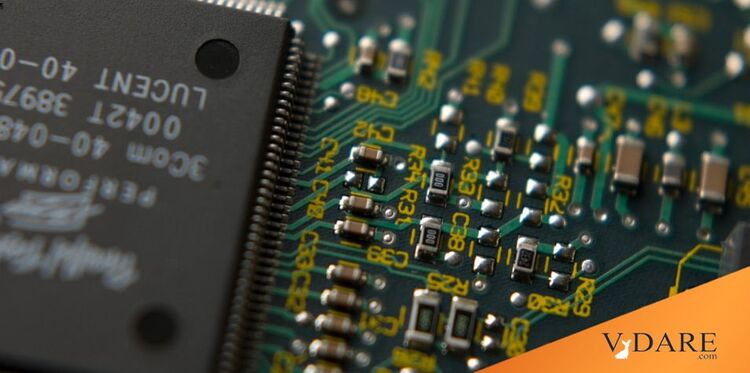Earlier: Are Visas Rotting In The Fields? The WSJ Thinks So!
The solution to all of America’s problems is never Americans and our brilliance, but immigrants, legal and illegal. Crops are always rotting in the fields. It is a never-ending threat—disaster and starvation in the United States are always just another illegal away. This used to be confined to agriculture, but then the dependence on aliens expanded to medical care, elderly care, programming, restaurants, accounting ... as if white Americans cannot do anything, while the truth is that white Americans are the nation’s most precious underutilized resource. We know that because white Americans are under a do-not-hire order from those who run the economy.
The latest implicit attack on white Americans and their ability to perform in the economy is the claim that the half-hearted attempt to re-shore semiconductor manufacturing will fail without increased immigration. It is as if American companies cannot manufacture semiconductors and Americans cannot do the work they did just 20 years ago.
The real solution to the semiconductor problem is to place a tariff on imported semiconductors to encourage the expansion of the domestic industry. No immigrants needed. Call it the same policy that the Republicans had just before the Civil War.
Instead we get even greater demands for more immigrants, who are being prohibited from entering the United States to run semiconductor manufacturing plants.
The US is experiencing a boom in semiconductor production after the passage of the CHIPS Act, but that progress could be impeded by a serious labor shortage in the industry.
According to a July report from the Semiconductor Industry Association, an industry trade group, and Oxford Economics, there will be 85,000 new technical jobs in the industry by 2030. But the report’s projections indicate that nearly 80% of those jobs could go unfilled.
And crucially, one-third of the semiconductor industry workforce is foreign-born—meaning that immigration hurdles are exacerbating the shortage.
The American Semiconductor Boom Faces A Massive Obstacle: A Lack Of Immigrants, by Adriana Belmonte, Yahoo, October 21, 2023
This claim is not true. Any foreign company opening a business in the United States can bring in an essentially unlimited number of executives and specialist employees. The only limitation is that the employee must be currently employed overseas by that company. This is the L-1 Non-Immigrant Visa (NIV); its purpose is to aid foreign companies to start businesses in the United States.
So, any company, Taiwanese, Korean, or Japanese, could easily transfer executives and specialist employees to the United States if they were serious about opening manufacturing in the United States.
I suspect that Taiwanese companies do not want to actually open up manufactories in the United States because that will make Taiwan less important strategically to the United States.
As for Japan and Korea, neither wants to transfer jobs overseas. Both nations worked hard to end their dependence on American semiconductors. They did so with both official and unofficial trade barriers. Both Korean chaebol and Japanese zaibatsu work closely with their national governments to block imports through tariffs and unofficial agreements to use only Korean and Japanese, respectively, domestic manufactures if possible. They will even take hits on costs for the long-term benefit of domestic manufacture, with many of those benefits not being especially in the interests of the company concerned, but in the national interest of full employment and national prosperity.
It was not too long ago that America gave up, voluntarily, her lead in semiconductor manufacturing.
The United States possessed approximately 12% of the world’s global chip manufacturing capacity as of 2021. This is a notably lower percentage of global capacity than the US enjoyed just a few decades previously (37% in 1990, for instance), before countries such as Taiwan and China ramped up their semiconductor production capabilities. Despite this decline, the semiconductor industry remains quite lucrative in the US. According to the Semiconductor Industry Association (SIA), semiconductors exports added $62 billion (USD) to the US economy in 2021, more than any product other than refined oil, aircraft, crude oil, and natural gas. Many of these imported chips return to the US in the form of finished consumer electronics.
Although the US held just 12% of the world’s total semiconductor manufacturing capacity in 2021, US-based companies held approximately 46.3 percent of the total semiconductor market share. This seeming discrepancy can be explained by both the dollar value of imported US semiconductors, outlined above, and the fact that many US-based companies own and operate semiconductor fabrication plants in other countries, such as Japan. In such cases, the manufacturing capacity is added to that country’s capacity rather than the capacity of the US, but the profits typically count as part of the US economy.
Semiconductor Manufacturing by Country 2023, World Population Review
Both Korea and Japan, in response to tariffs and quotas on automobile imports, opened up manufacturing plants in the United States. Today most Korean and Japanese cars sold in the United States are built here. Honda, Kia, Hyundai, Toyota, etc. all have mostly non-union plants in the South, as do many European manufacturers, such as BMW, Mercedes, and Volkswagen. Those companies were essentially forced to open manufacturing in the United States by tariffs and quotas.
The same can be done with semiconductors. Or American companies can expand—just give those companies tax breaks, as Japan, Korea, and Taiwan did to attract manufacturers in the 1990s. We can also encourage American companies to form self-supporting relationships similar to chaebol and zaibatsu to aid the national economy and prosperity for all.
There is no need for more immigrants. Just give semiconductor manufacturers long-term assurances that tariffs and other policies will provide a long-term market for their products. A sort of Sailer Strategy for domestic manufacturing, a kind of Affordable Employer Formation through high tariffs where both capital and workers win! I think there’s a term for that … a Whig Tariff, or a National Industrial Policy.













